Research on the Vibration Characteristics of a Track’s Structure Considering the Viscoelastic Properties of Recycled Composite Sleepers
Abstract
:Featured Application
Abstract
1. Introduction
2. Viscoelastic Properties of Composite Sleepers
3. Model and Calculation Method
3.1. Vehicle Model
3.2. Track Model
3.3. Wheel–Rail Interaction
3.4. Model Validation
3.5. Calculation Method
4. Results and Discussion
4.1. Considering the Influence of the Viscoelastic Properties of Composite Sleepers on the Dynamic Characteristics of the Track Structure
4.2. Comparative Analysis of Composite Sleeper and Type-III Sleeper-Ballasted Track
4.3. Comparative Analysis of Composite Sleeper Track under Different Temperatures
5. Conclusions
Author Contributions
Funding
Acknowledgments
Conflicts of Interest
References
- Newby, P.R.T.; Stölzel, R. Modern Railway Track. Photogramm. Rec. 2003, 18, 81–83. [Google Scholar] [CrossRef]
- Qiao, P.; Davalos, J.F.; Zipfel, M.G. Modeling and optimal design of composite-reinforced wood railroad crosstie. Compos. Struct. 1998, 41, 87–96. [Google Scholar] [CrossRef]
- Ferdous, W.; Manalo, A. Failures of mainline railway sleepers and suggested remedies—Review of current practice. Eng. Fail. Anal. 2014, 44, 17–35. [Google Scholar] [CrossRef]
- Bolin, C.A.; Smith, S.T. Life Cycle Assessment of Creosote-Treated Wooden Railroad Crossties in the US with Comparisons to Concrete and Plastic Composite Railroad Crossties. J. Transp. Technol. 2013, 3, 149–161. [Google Scholar] [CrossRef] [Green Version]
- Manalo, A.; Aravinthan, T.; Karunasena, W.; Ticoalu, A. A review of alternative materials for replacing existing timber sleepers. Compos. Struct. 2010, 92, 603–611. [Google Scholar] [CrossRef]
- Ferdous, W.; Manalo, A.; Van Erp, G.; Aravinthan, T.; Kaewunruen, S.; Remennikov, A. Composite railway sleepers—Recent de-velopments, challenges and future prospects. Compos. Struct. 2015, 134, 158–168. [Google Scholar] [CrossRef]
- Xiao, S.L.; Lin, H.; Shi, S.Q.; Cai, L. Optimum processing parameters for wood-bamboo hybrid composite sleepers. J. Reinf. Plast. Compos. 2014, 33, 2010–2018. [Google Scholar] [CrossRef]
- Ferdous, W.; Manalo, A.C.; Van Erp, G.; Aravinthan, T.; Ghabraie, K. Evaluation of an Innovative Composite Railway Sleeper for a Narrow-Gauge Track under Static Load. J. Compos. Constr. 2018, 22, 04017050. [Google Scholar] [CrossRef]
- Lotfy, I.; Farhat, M.; Issa, M.A. Effect of pre-drilling, loading rate and temperature variation on the behavior of railroad spikes used for high-density-polyethylene crossties. Proc. Inst. Mech. Eng. Part F J. Rail Rapid Transit 2016, 231, 44–56. [Google Scholar] [CrossRef]
- Lotfy, I.; Farhat, M.; Issa, M.A.; Al-Obaidi, M. Flexural behavior of high-density polyethylene railroad crossties. Proc. Inst. Mech. Eng. Part F J. Rail Rapid Transit 2015, 230, 813–824. [Google Scholar] [CrossRef]
- Lotfy, I.; Farhat, M.; Issa, M.A. The effect of temperature on the performance of glass-fiber-reinforced high-density polyethylene composite railroad crossties. Proc. Inst. Mech. Eng. Part F J. Rail Rapid Transit 2015, 230, 1145–1157. [Google Scholar] [CrossRef]
- Lotfy, I.; Issa, M.A. Evaluation of the longitudinal restraint, uplift resistance, and long-term performance of high-density poly-ethylene crosstie rail support system using static and cyclic loading. Proc. Inst. Mech. Eng. Part F J. Rail Rapid Transit 2017, 1–15. [Google Scholar] [CrossRef]
- Ferro, E.; Harkness, J.; Le Pen, L. The influence of sleeper material characteristics on railway track behaviour: Concrete vs. composite sleeper. Transp. Geotech. 2020, 23, 100348. [Google Scholar] [CrossRef]
- Kaewunruen, S.; You, R.; Ishida, M. Composites for Timber-Replacement Bearers in Railway Switches and Crossings. Infrastructures 2017, 2, 13. [Google Scholar] [CrossRef] [Green Version]
- Jing, G.; Qiang, W. Experiments and Optimize Analysis of Lateral Resistance of Composite Sleeper. Railw. Stand. Des. 2020, 64, 1–8. [Google Scholar]
- Zhao, Z.; Shen, Y.; Wei, Q.; Jiang, W.; Geng, H.; Li, C. Experimental study on dynamic performance of composite sleeper ballasted track. J. Cent. South Univ. Sci. Technol. 2019, 50, 234–240. [Google Scholar]
- Duan, H. Study on the Vertical Dynamic Behavior of Recycled Plastic Composite Crosstie Ballast Structure. Master’s Thesis, Southwest Jiaotong University, Chengdu, China, 2017. [Google Scholar]
- Zheng, J. The Methods to Increase the Elasticity of Ballast Track and Their influence on the Mechanical Properties of Ballast Track. Master’s Thesis, Southwest Jiaotong University, Chengdu, China, 2017. [Google Scholar]
- Goyder, H.; White, R. Vibrational power flow from machines into built-up structures, part II: Wave propagation and power flow in beam-stiffened plates. J. Sound Vib. 1980, 68, 77–96. [Google Scholar] [CrossRef]
- Goyder, H.; White, R. Vibrational power flow from machines into built-up structures, part I: Introduction and approximate analyses of beam and plate-like foundations. J. Sound Vib. 1980, 68, 59–75. [Google Scholar] [CrossRef]
- Li, W.; Lavrich, P. Prediction of Power Flows through Machine Vibration Isolators. J. Sound Vib. 1999, 224, 757–774. [Google Scholar] [CrossRef]
- Zhu, X.; Li, T.; Zhao, Y.; Yan, J. Vibrational power flow analysis of thin cylindrical shell with a circumferential surface crack. J. Sound Vib. 2007, 302, 332–349. [Google Scholar] [CrossRef]
- Yang, J.; Xiong, Y.; Xing, J. Vibration power flow and force transmission behaviour of a nonlinear isolator mounted on a nonlinear base. Int. J. Mech. Sci. 2016, 115, 238–252. [Google Scholar] [CrossRef]
- Fu, N.; Liu, Y.; Zhao, Z.; Li, C. Study of Vibration Energy Properties of Double-block Ballastless Damping Track. J. China Railw. Soc. 2018, 40, 111–118. [Google Scholar]
- Jiang, H.; Gao, L. Analysis of the Vibration Characteristics of Ballastless Track on Bridges Using an Energy Method. Appl. Sci. 2020, 10, 2289. [Google Scholar] [CrossRef] [Green Version]
- Jiang, H.; Gao, L. Study of the Vibration-Energy Properties of the CRTS-III Track Based on the Power Flow Method. Symmetry 2020, 12, 69. [Google Scholar] [CrossRef] [Green Version]
- Zhu, S.; Cai, C.; Luo, Z.; Liao, Z. A frequency and amplitude dependent model of rail pads for the dynamic analysis of train-track interaction. Sci. China Ser. E Technol. Sci. 2014, 58, 191–201. [Google Scholar] [CrossRef]
- Oregui, M.; De Man, A.; Woldekidan, M.; Li, Z.; Dollevoet, R. Obtaining railpad properties via dynamic mechanical analysis. J. Sound Vib. 2016, 363, 460–472. [Google Scholar] [CrossRef]
- Zhao, Z.; Shen, Y.; Yan, X.; Su, Q. Study on Vertical Dynamic Characteristics of Composite Sleeper Ballasted Track in Tunnels. In Proceedings of the 1st International Conference on Advances in Civil Engineering and Materials (ACEM1), Nanjing, China, 9–11 November 2018. [Google Scholar]
- Li, T.; Su, Q.; Kaewunruen, S. Saturated Ground Vibration Analysis Based on a Three-Dimensional Coupled Train-Track-Soil Interaction Model. Appl. Sci. 2019, 9, 4991. [Google Scholar] [CrossRef] [Green Version]
- Zhai, W.; Wang, K.; Cai, C. Fundamentals of vehicle–track coupled dynamics. Veh. Syst. Dyn. 2009, 47, 1349–1376. [Google Scholar] [CrossRef]
- Yang, S.-C.; Jang, S.-Y.; Kim, E. Determination of Upper Limit of Rail Pad Stiffness for Ballasted and Concrete Track of High-Speed Railway Considering Running Safety. J. Korean Soc. Railw. 2011, 14, 526–534. [Google Scholar] [CrossRef] [Green Version]
- Zhai, W.; Xia, H.; Cai, C.; Gao, M.; Li, X.; Guo, X.; Zhang, N.; Wang, K. High-speed train–track–bridge dynamic interactions—Part I: Theoretical model and numerical simulation. Int. J. Rail. Transp. 2013, 1, 3–24. [Google Scholar] [CrossRef]
- True, H. Vehicle-Track Coupled Dynamics. Veh. Syst. Dyn. 2020, 1–3. [Google Scholar] [CrossRef]
- Knothe, K.; Grassie, S.L. Modelling of Railway Track and Vehicle/Track Interaction at High Frequencies. Veh. Syst. Dyn. 1993, 22, 209–262. [Google Scholar] [CrossRef]
- Cai, X.; Zhong, Y.; Hao, X.; Zhang, Y.; Cui, R. Dynamic behavior of a polyurethane foam solidified ballasted track in a heavy haul railway tunnel. Adv. Struct. Eng. 2019, 22, 751–764. [Google Scholar] [CrossRef]
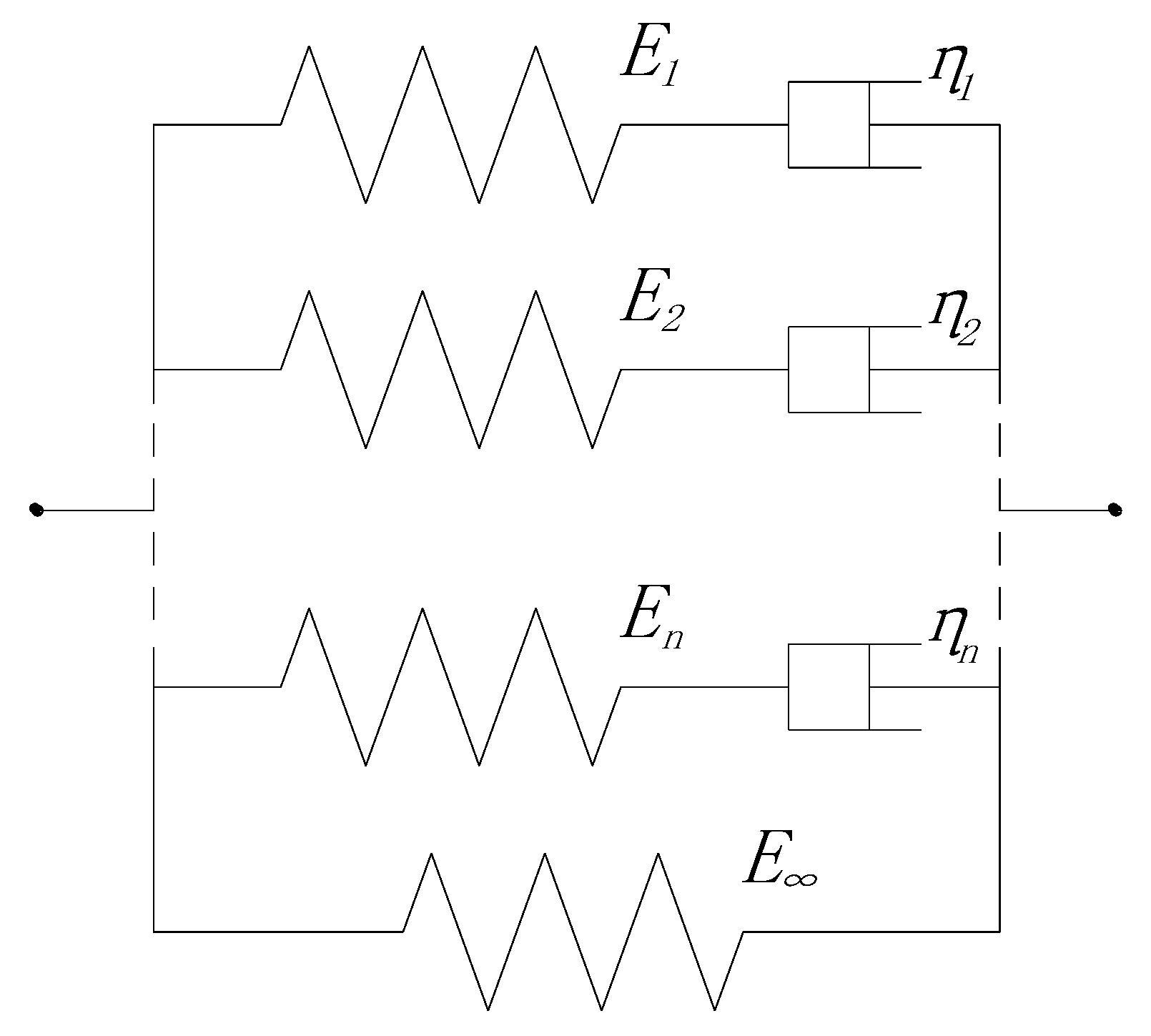
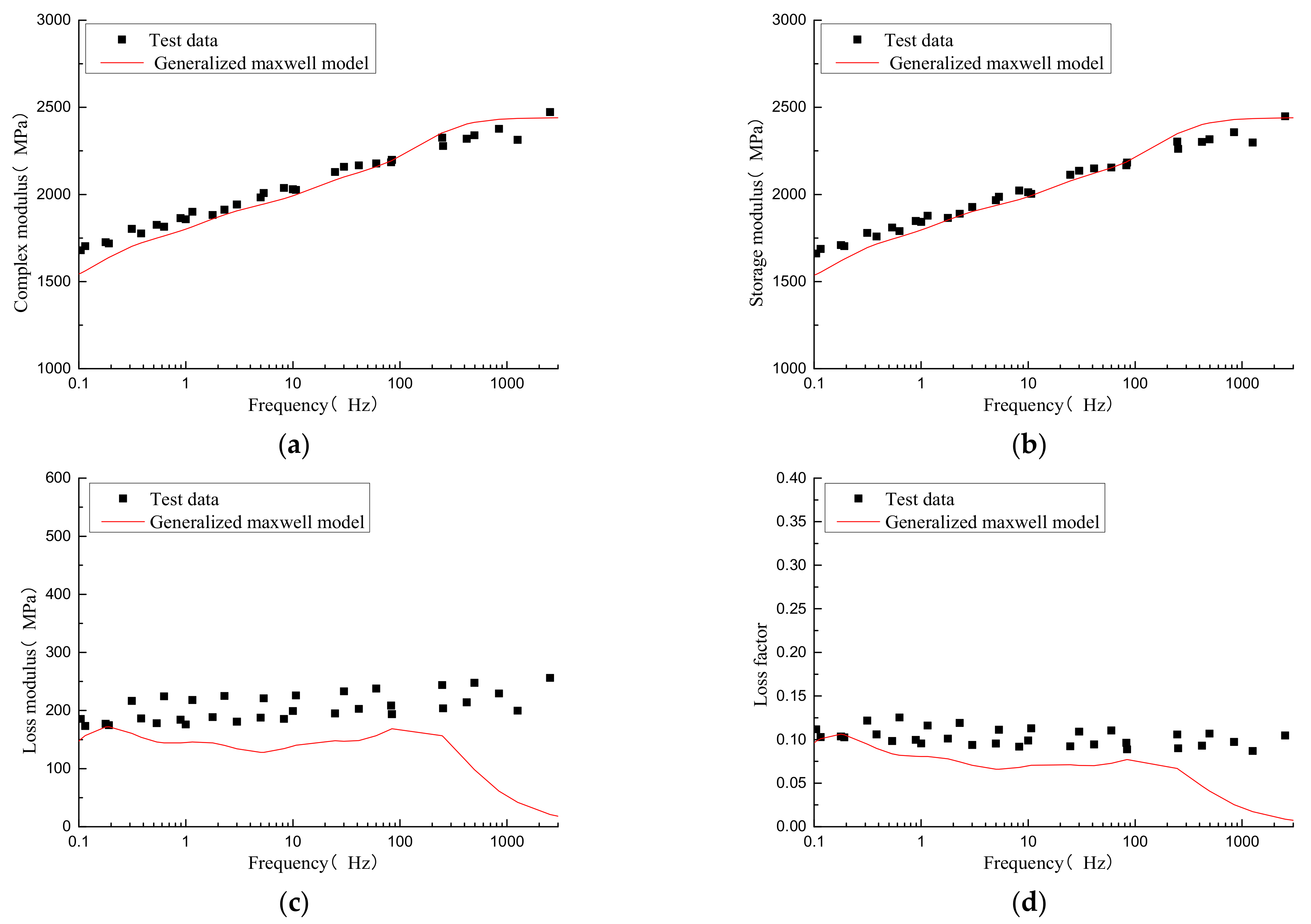

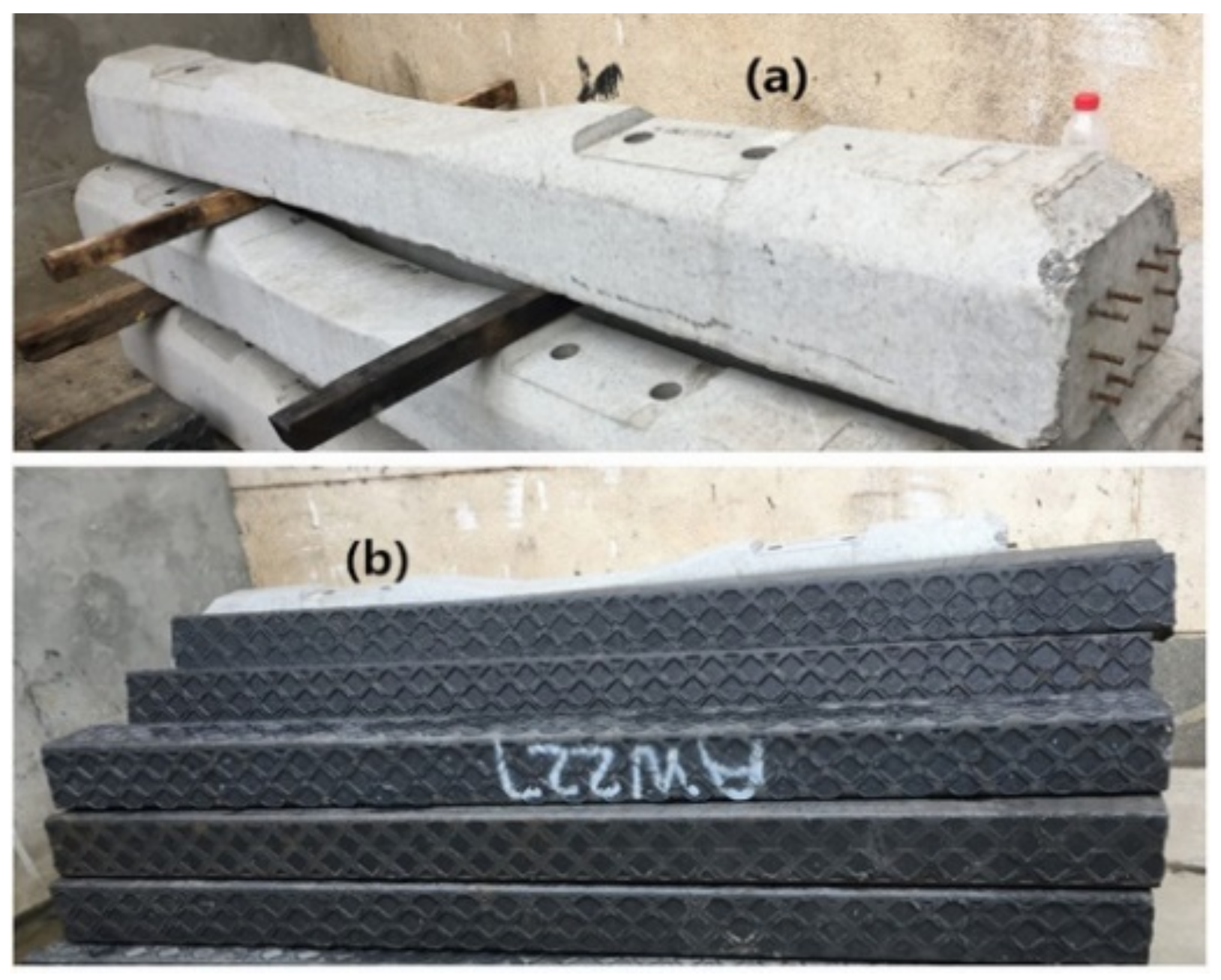
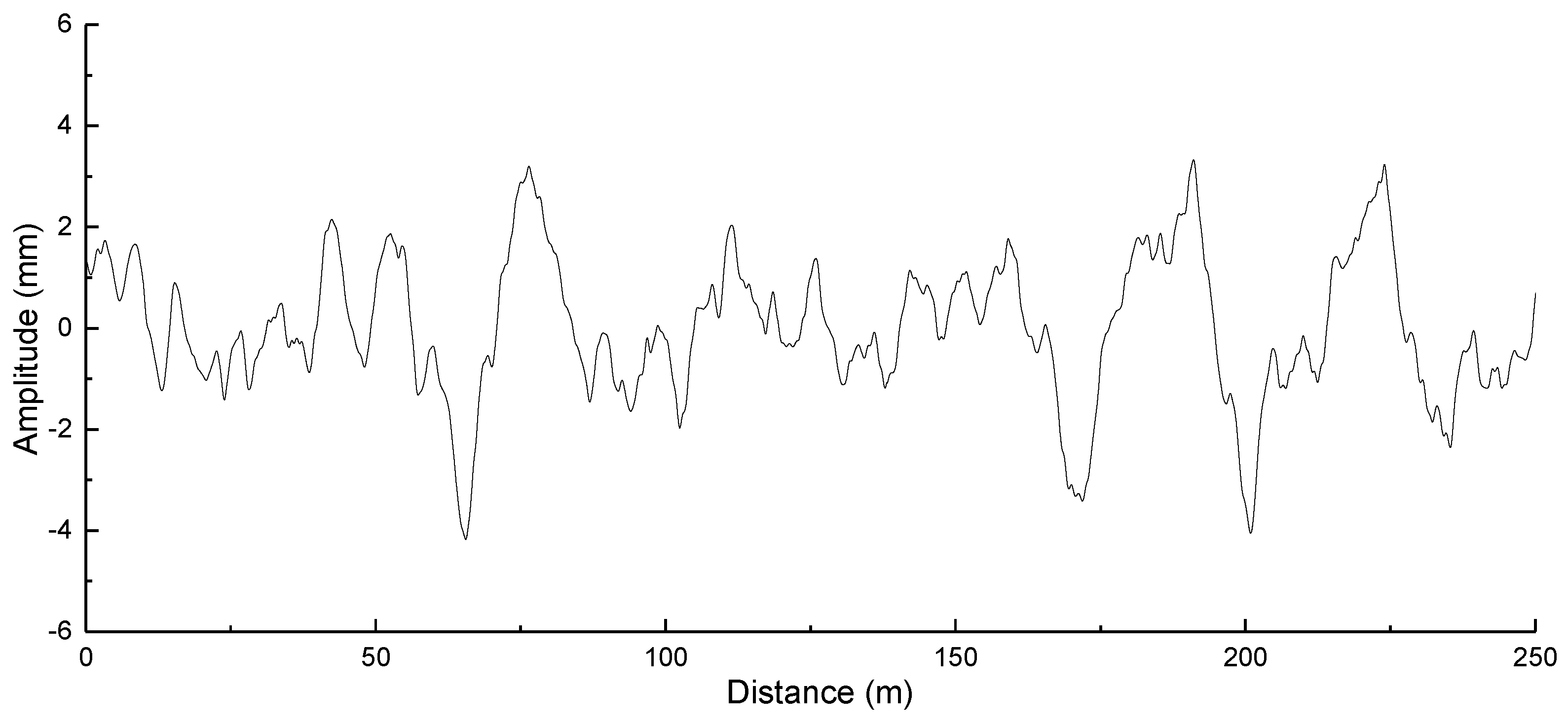
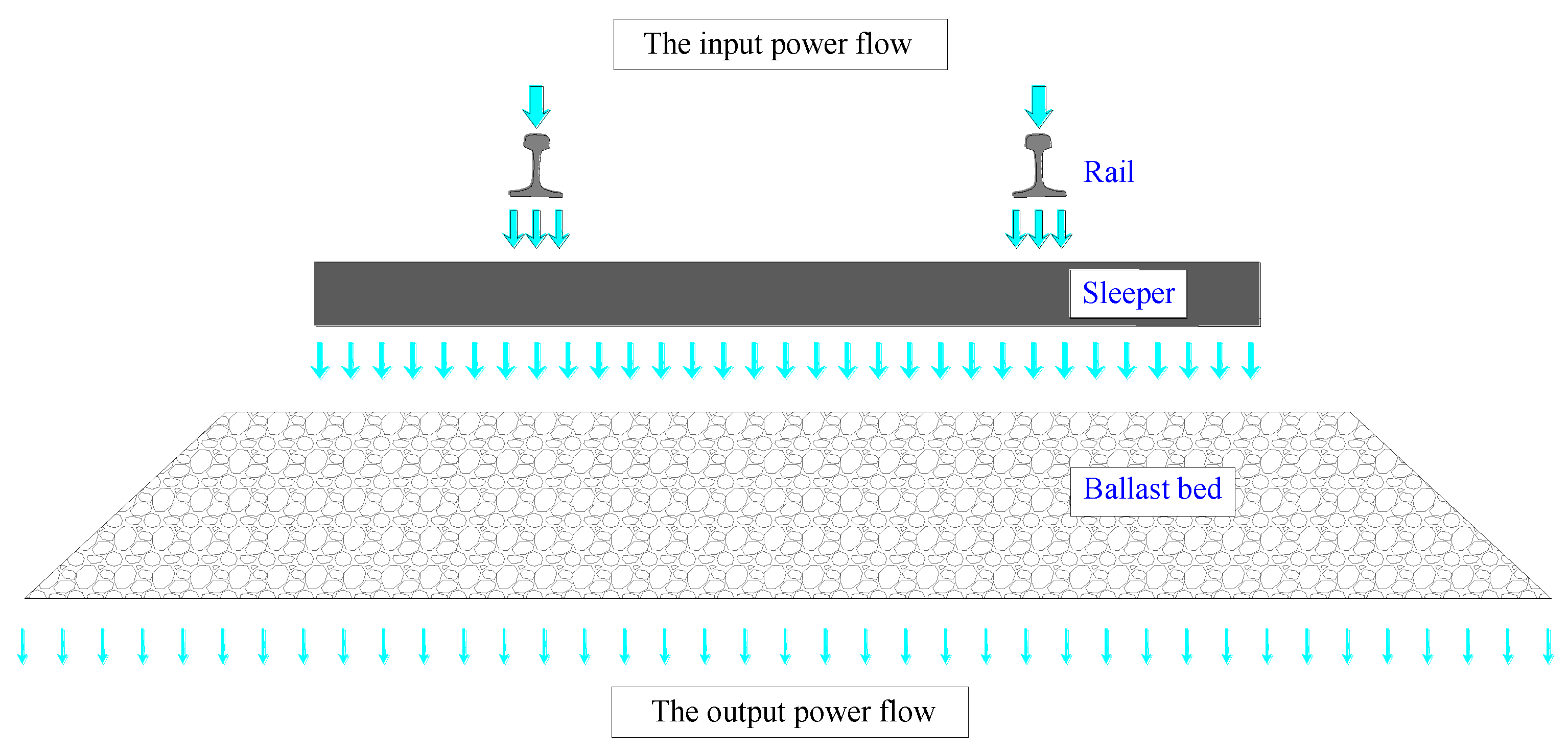

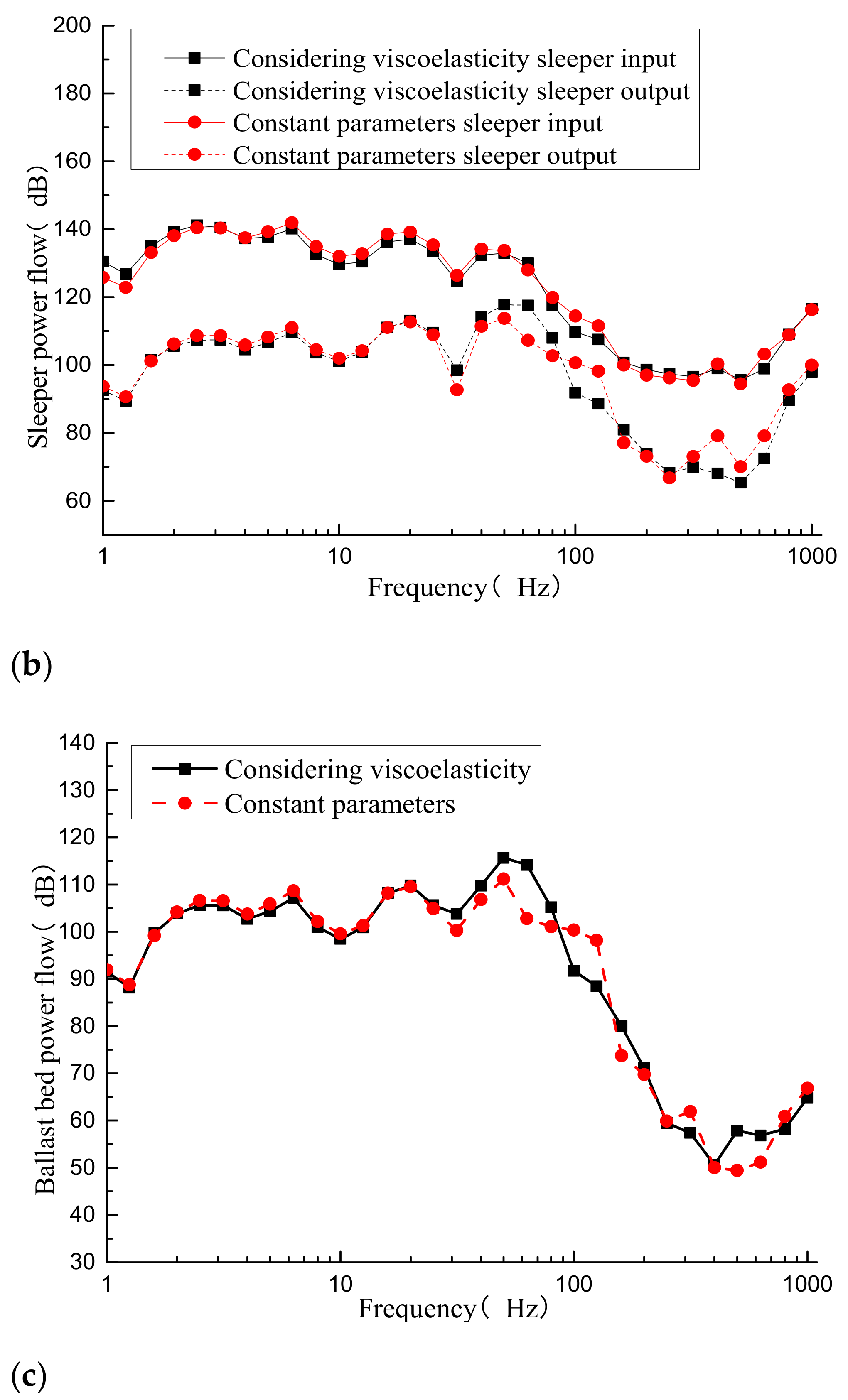
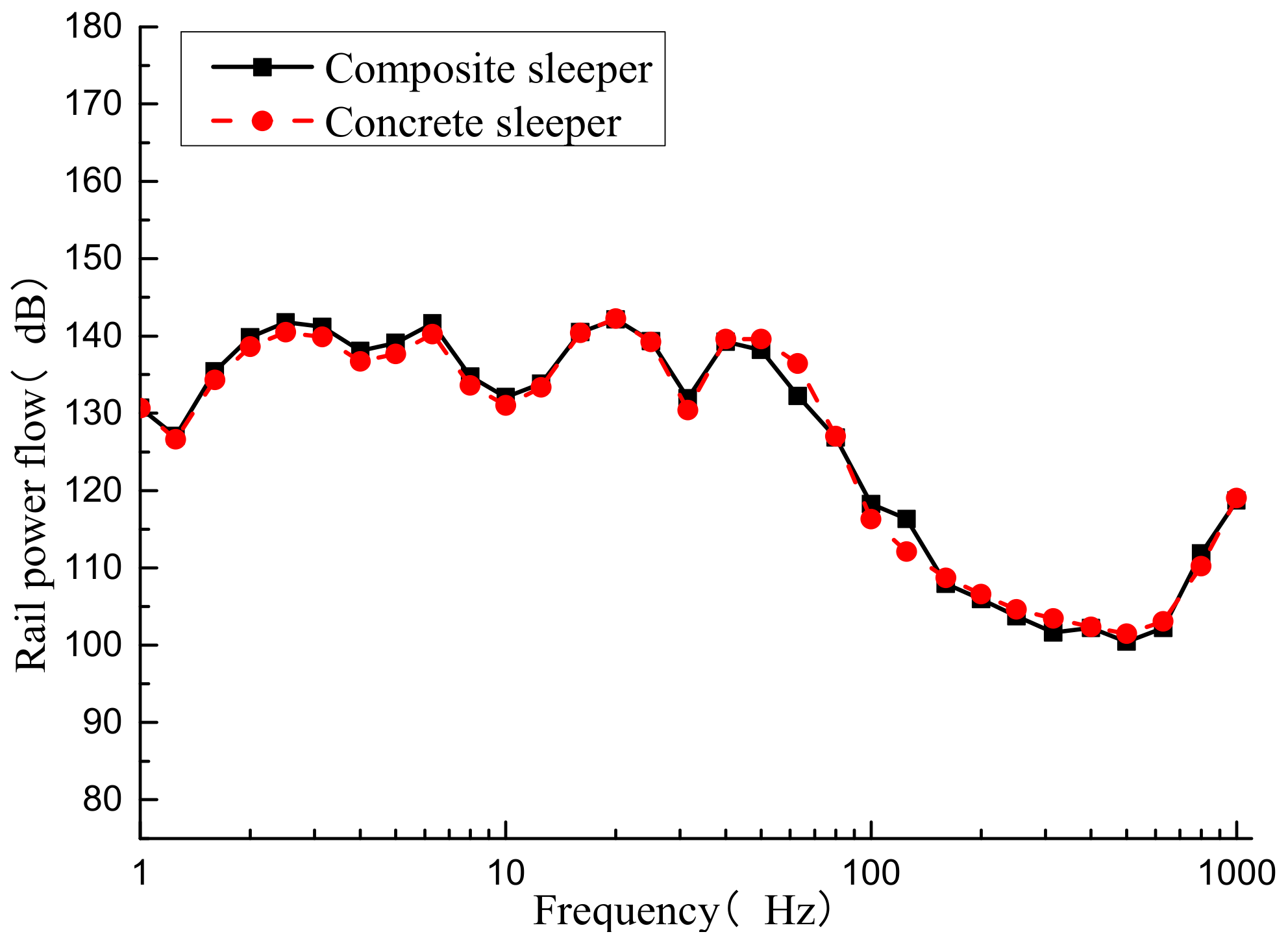
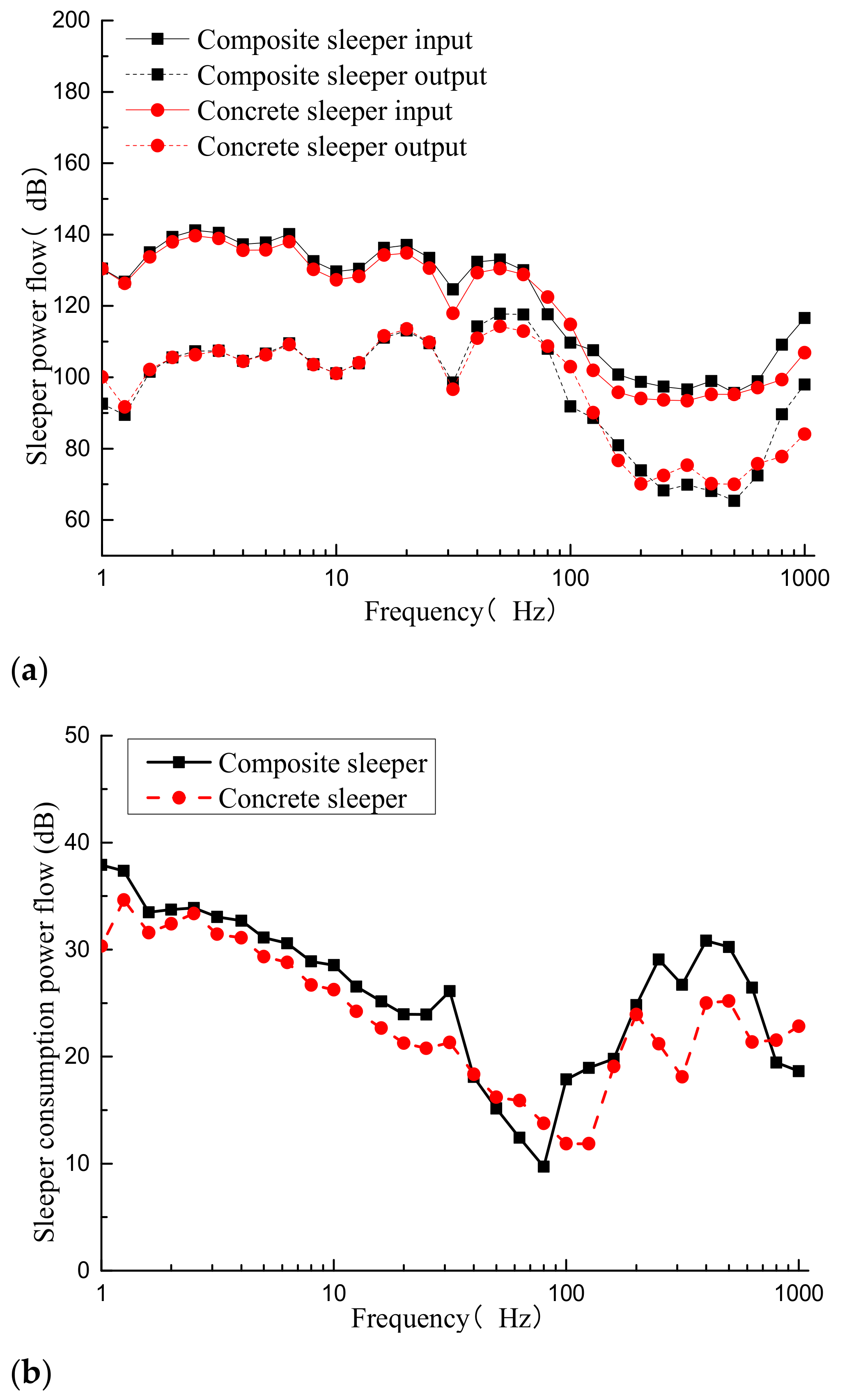
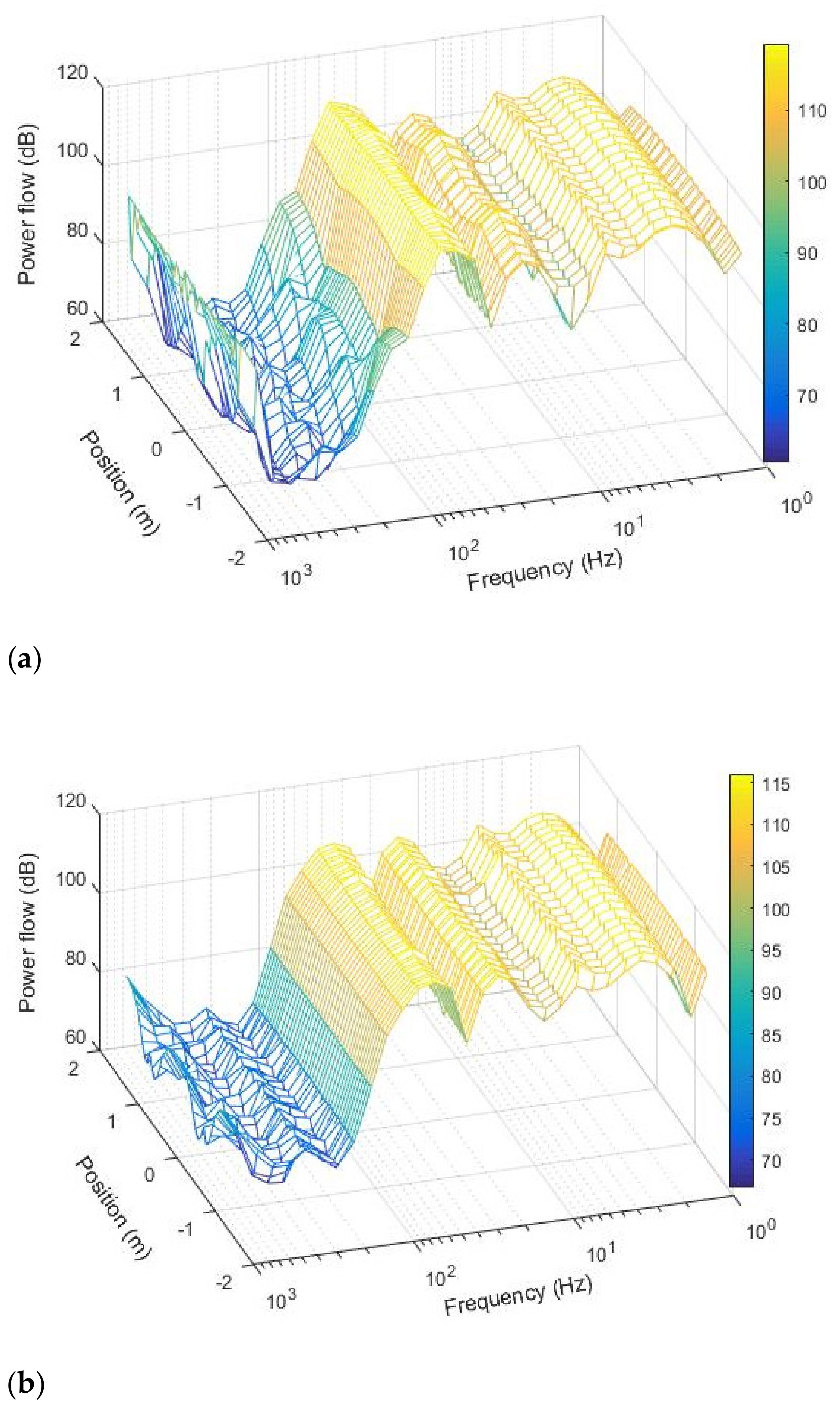
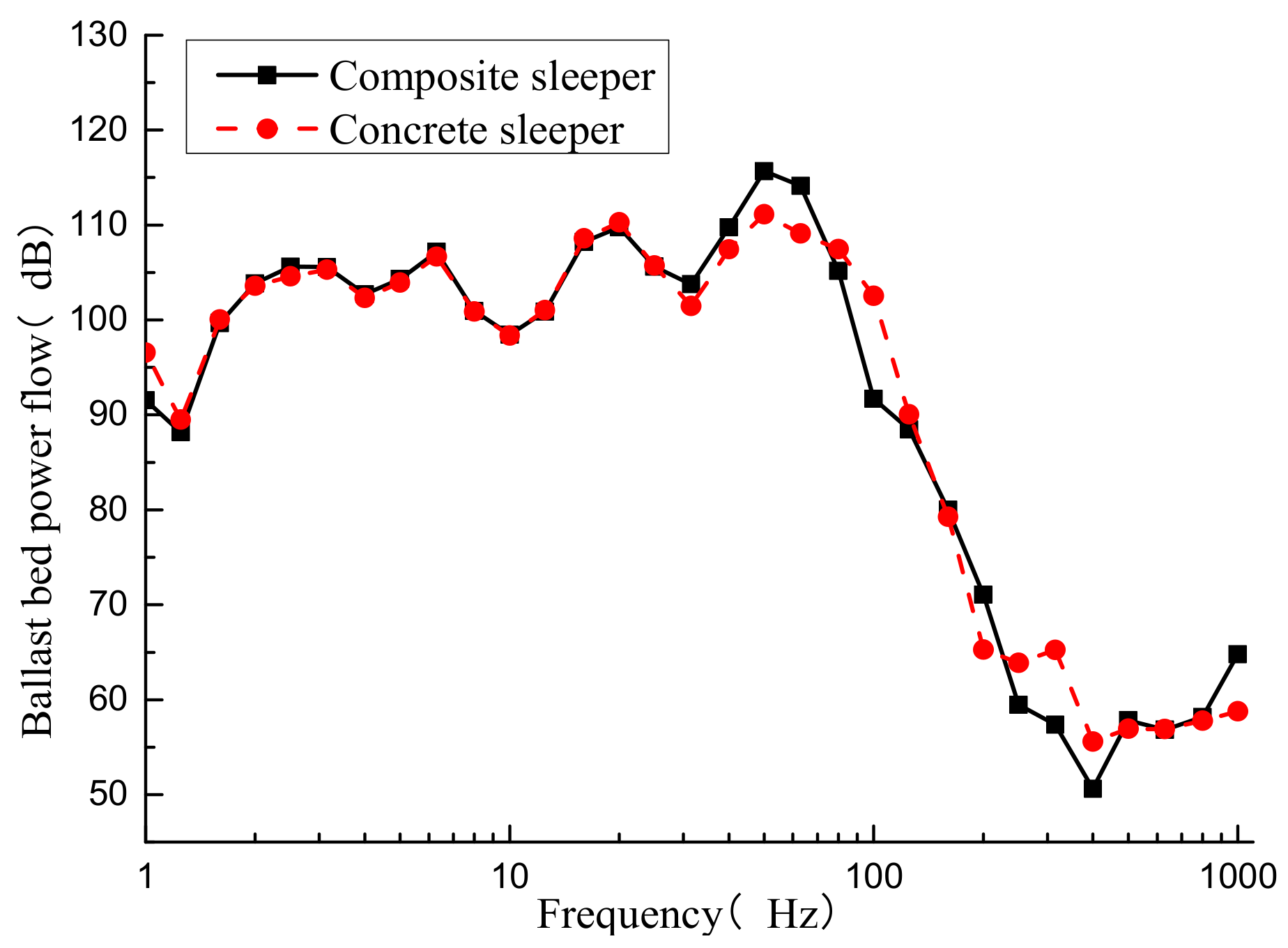
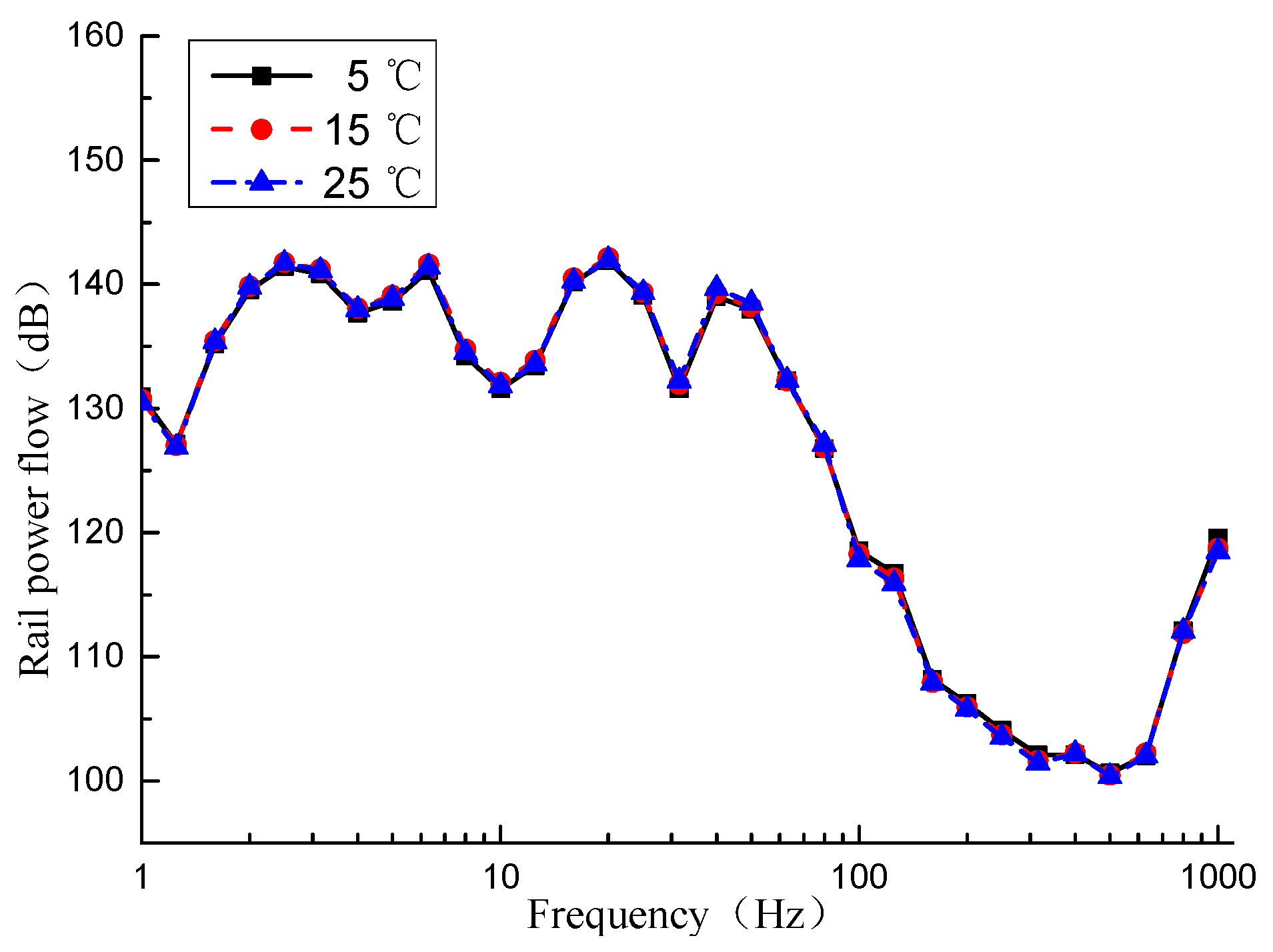
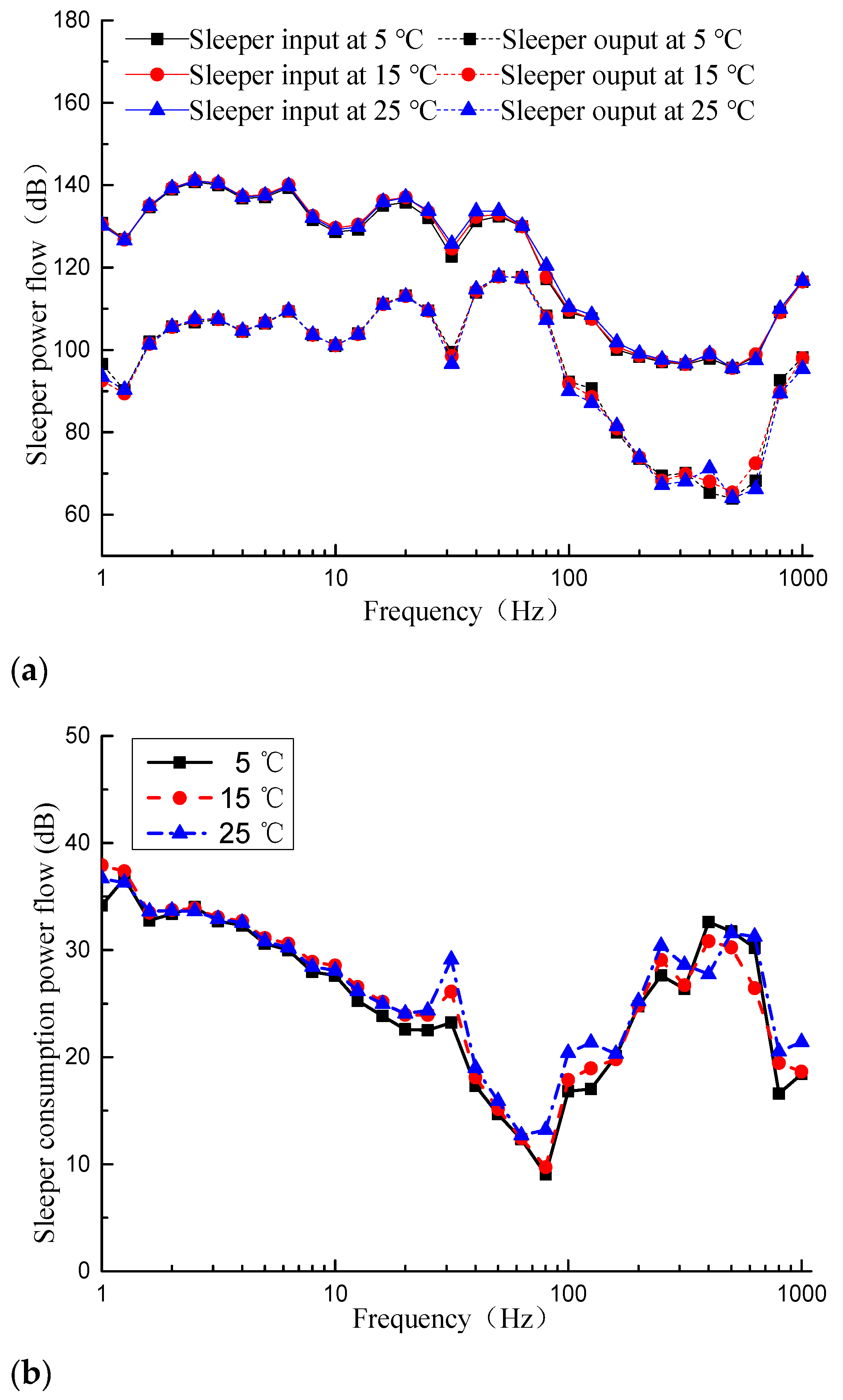
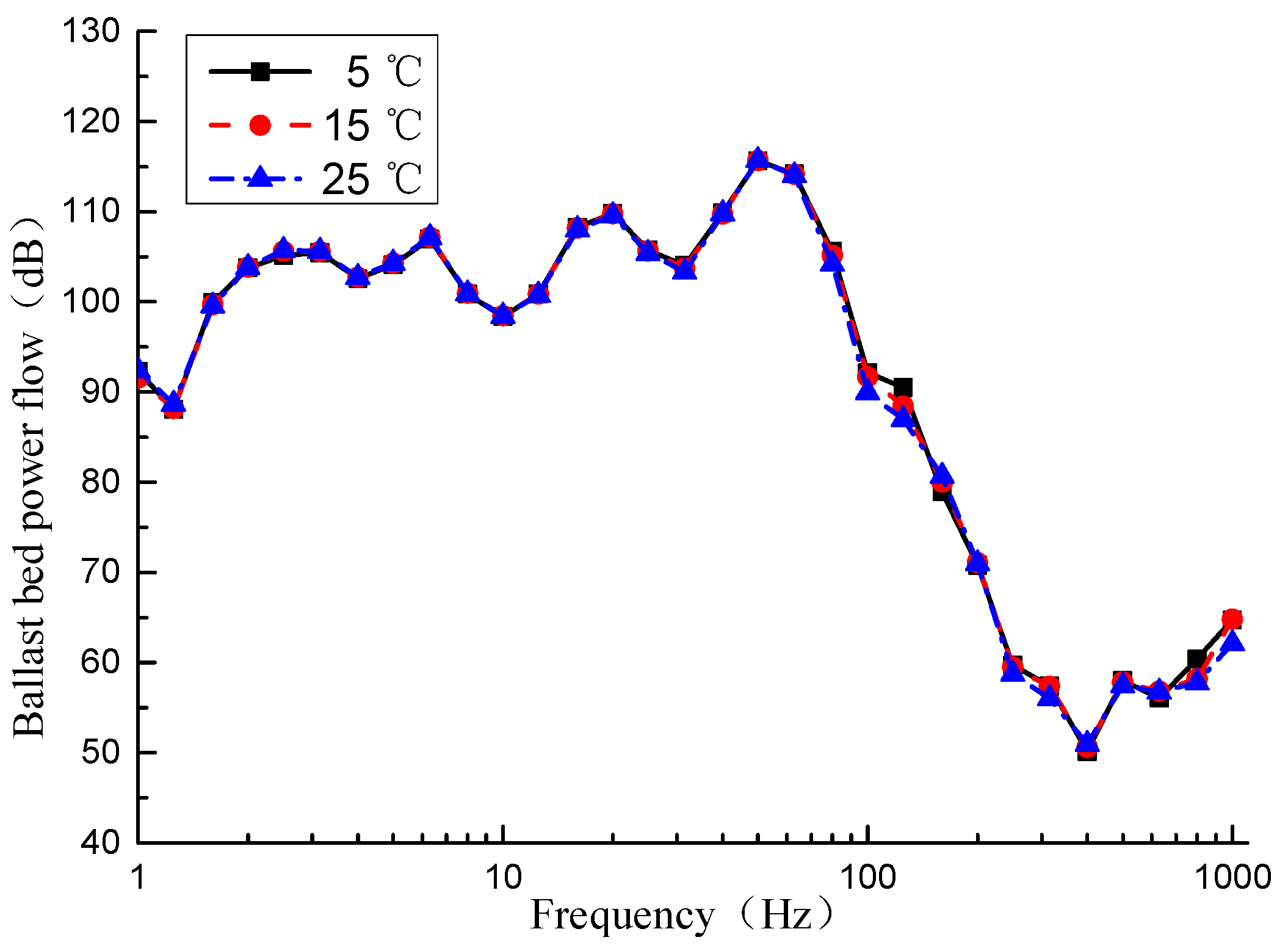
| Parameters | Temperature/°C | ||
|---|---|---|---|
| 5 | 15 | 25 | |
| /MPa | 1600 | 1450 | 1200 |
| /MPa | 480 | 299 | 278 |
| /s | 1 | 1 | 1 |
| /MPa | 178 | 188 | 229 |
| /s | 0.1 | 0.1 | 0.1 |
| /MPa | 150 | 189 | 125 |
| /s | 0.01 | 0.01 | 0.01 |
| /MPa | 287 | 315 | 359 |
| /s | 0.001 | 0.001 | 0.001 |
| Name | Unit | Value |
|---|---|---|
| Mass of car body | kg | 3.96 × 104 |
| Mass of bogie | kg | 3.5 × 103 |
| Mass of wheelset | kg | 2.0 × 103 |
| Pitching moment of inertia of car | kg·m2 | 1.94 × 106 |
| Pitching moment of inertia of bogie | kg·m2 | 1.752 × 103 |
| Vertical stiffness of primary suspension | N/m | 1.89 × 106 |
| Vertical stiffness of secondary suspension | N/m | 1.176 × 106 |
| Vertical damping of primary suspension | N·s/m | 1.96 × 104 |
| Vertical damping of secondary suspension | N·s/m | 4.0 × 104 |
| Fixed axle spacing | m | 2.5 × 100 |
| Bogie center distance | m | 1.75 × 10 |
| Wheel radius | m | 4.3 × 10−1 |
| Parameters | Unit | Value | |
|---|---|---|---|
| Rail | Elastic modulus | N/m2 | 2.06 × 1011 |
| Moment of inertia | m4 | 3.217 × 10−5 | |
| Mass per unit length | kg/m | 6.064 × 10 | |
| Poisson ratio | - | 3.0 × 10−1 | |
| Fastener | Vertical stiffness | N/m | 6.0 × 107 |
| Vertical damping | N·s/m | 7.5 × 104 | |
| Composite sleeper | Density | kg/m3 | 1.097 × 103 |
| Length/width/height | m | 2.7/0.22/0.18 | |
| Type-III sleeper | Elastic modulus | N/m2 | 3.6 × 1010 |
| Density | kg/m3 | 2.5 × 103 | |
| Poisson ratio | - | 2.0 × 10−1 | |
| Loss factor | - | 1.0 × 10−2 | |
| Length/width/height | m | 2.6/0.3/0.23 | |
| Ballast bed | Mass | kg | 6.5 × 102 |
| Vertical stiffness | N/m | 2.4 × 108 | |
| Vertical damping | N·s/m | 6.0 × 104 | |
| Shear stiffness | N/m | 7.8 × 107 | |
| Shear damping | N·s/m | 8.0 × 104 | |
| Subgrade | Vertical stiffness | N/m | 2.4 × 108 |
| Vertical damping | N·s/m | 6.0 × 104 | |
| Dynamic Responses | Duan [17] | This Paper |
|---|---|---|
| Rail displacement (mm) | 1.41 | 1.38 |
| Sleeper displacement (mm) | 0.90 | 0.87 |
| Sleeper von Mises stress (MPa) | 1.45 | 1.12 |
| Ballast bed displacement (mm) | 0.24 | 0.22 |
Publisher’s Note: MDPI stays neutral with regard to jurisdictional claims in published maps and institutional affiliations. |
© 2020 by the authors. Licensee MDPI, Basel, Switzerland. This article is an open access article distributed under the terms and conditions of the Creative Commons Attribution (CC BY) license (http://creativecommons.org/licenses/by/4.0/).
Share and Cite
Zhao, Z.; Gao, Y.; Li, C. Research on the Vibration Characteristics of a Track’s Structure Considering the Viscoelastic Properties of Recycled Composite Sleepers. Appl. Sci. 2021, 11, 150. https://doi.org/10.3390/app11010150
Zhao Z, Gao Y, Li C. Research on the Vibration Characteristics of a Track’s Structure Considering the Viscoelastic Properties of Recycled Composite Sleepers. Applied Sciences. 2021; 11(1):150. https://doi.org/10.3390/app11010150
Chicago/Turabian StyleZhao, Zhenhang, Ying Gao, and Chenghui Li. 2021. "Research on the Vibration Characteristics of a Track’s Structure Considering the Viscoelastic Properties of Recycled Composite Sleepers" Applied Sciences 11, no. 1: 150. https://doi.org/10.3390/app11010150
APA StyleZhao, Z., Gao, Y., & Li, C. (2021). Research on the Vibration Characteristics of a Track’s Structure Considering the Viscoelastic Properties of Recycled Composite Sleepers. Applied Sciences, 11(1), 150. https://doi.org/10.3390/app11010150





